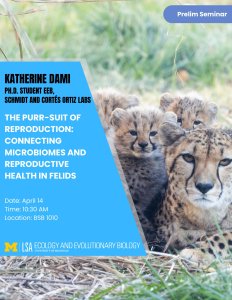Presented By: Ecology and Evolutionary Biology
EEB Prelim Seminar Series - The purr-suit of reproduction: connecting microbiomes and reproductive health in Felids
Katherine Dami, PhD Student EEB, Schmidt and Cortés Ortiz Labs

Summary: The communities of microbes that inhabit the gut and reproductive tract, known as the gut and reproductive microbiomes, show a symbiotic relationship that influences host physiology and reproductive outcomes. This can be seen in the gut microbiome’s influence on nutrient acquisition, the production of biologically active molecules, and the modification of steroid hormones, as well as in reproductive microbiomes’ impacts on sperm quality, assisted reproductive technology success, embryo quality, susceptibility to STIs, and offspring health. While the majority of research into these topics is in humans, mice, and livestock, investigations into wildlife species have also revealed similar patterns. However, further research is still needed across a broader range of taxa, particularly in species with low reproductive success that depend on consistent reproduction to be self-sustaining. Ex situ populations of cheetahs (Acinonyx jubatus) and clouded leopards (Neofelis nebulosa) that are part of American Association of Zoos and Aquariums Species Survival Plans (AZA SSP), are two such populations that have poor reproduction and rely on conservation husbandry for population health and survival. Therefore, the main goal of my dissertation is to investigate the relationship between the gut, vaginal, preputial, and seminal microbiomes and reproductive phenotypes and physiology in these two threatened species, along with their model species, the domestic cat (Felis catus), in order to extend the applicability of this research to other threatened felids.